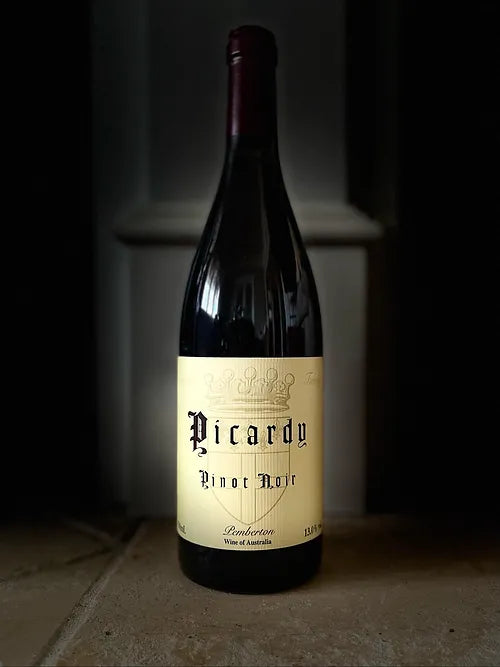Picardy
2022 Picardy Pinot Noir
2022 Picardy Pinot Noir
Couldn't load pickup availability
The first wine produced at Picardy was the 1996 Pinot Noir. Picardy Pinots exhibit finesse and complexity, inspired by the great Pinot Noir wines of the old world.
Excellent fruit intensity, structure, pH to acid relationship and fine-grained tannins guarantee long life and excellent bottle development. The wines are also very approachable in their early years.
Since the first vintage in 1996, an increase in new clonal plantings and an advance in vine age has resulted in wines of greater texture, structure and complexity. Picardy Pinot Noir consists of 11 clones: upright, droopy (existing clones in Australia) and clones 114, 115 and 777 (which are special selections from the University of Dijon) as well as 6 new clones imported from Burgundy. It took 21 years - from the time Bill supervised the sourcing of these clones - until the last one was finally delivered to Picardy from quarantine in 2011.
asting note by Shanteh Wale
"This is a wine with plenty of distinction, not only because it is one of Western Australia's top produced Pinot Noirs but because of its unique shape and perfume.
Hibiscus and climbing rose blooms invite you in. Morello cherries, Satsuma plums and pomegranate make you at ease. You are then met with the robust personalities of Red bush tea, pimento and cedarwood. There is a deep echoing base note of terra cotta and woodsy herbs. Autumn leaves and ground nutmeg spice too.
On the palate, beautifully ripe red fruit fills the room, with matching tempo acidity. Tannins are fine and particularly svelte in this vintage. A densely packed wine with considerable fruit concentration. Drinking very well but will have the ability to go another 5-8 years. Picardy makes wines for the future in mind."
Tasting note by Ambrose Nock:
Picardy Pinot Noir 2022 "Enthrallingly fragrant, charming and opulent; reminiscent of a stroll through an English garden. The palate is lustrous and complex, channelling the essence of Picardy Pinot Noir. Petals, cherries and all-spice lead the way, with Turkish delight and fresh pomegranate thrown in for good measure.
Great Pinot Noir is about shape and texture, and here it is in spades, with pockets of complexity emerging through the multi-dimensional palate. High class oak, with the signature sour note (at this early stage of its development) helping to drive the length.
A masterful touch and fantastic growing season coming together again, encapsulating jaw-dropping beauty into a 750ml bottle."

Shipping Info
-
Western Australian Orders:
- $10 shipping fee for 6 bottle orders or complimentary shipping of 12+ bottle orders
- Cases can be 6 or 12 bottles
- Mixed cases are welcome
- Please order in multiples of 6 (ie. 6, 12, 18 or 24 bottles)
- Please allow 2 weeks for deliveries
-
Interstate Orders
- $20 shipping per case
- Cases can be 6 or 12 bottles
- Mixed cases are welcome
- Please order in multiples of 6 (ie. 6, 12, 18 or 24 bottles)
- Please allow 2 weeks for deliveries

